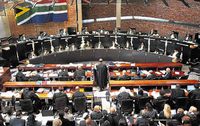3 Watershed legal judgments
Court judgements are often seen to be confined to the realm of lawyers or legal scholars. However, if you look at it in a different way, legal cases are war stories, battled out in the courtrooms. South Africa has a long history of courtroom battles that gave way to landmark judgements. For this article I will talk about three judgements spanning over 60 years which are important for South Africans to know about.
1. Coloured Voters Cases:
One of the founding values of the Constitution is universal adult suffrage and a national common voters’ roll. These provisions are in stark contrast to what came before in South Africa. When the apartheid regime was established under the National Party (NP) in 1948, one of its policies was to put the coloured male voters on a separate voting roll. Before 1910 the voting laws for the Cape Colony permitted all males over the age of 21 to vote, providing each person could sign their name, occupation, and address. In addition, they also needed to own some property or earn above a certain threshold of 50 dollars a year. The Separate Representation of Voters Act of 1951 was introduced. In order to affect this kind of radical change, the National Party needed a 2/3rds majority in both houses of parliament. They were unable to achieve this even after the 1953 election.
In order to circumvent this, rule the NP adopted three crucial acts of parliament. The first increased the number of judges who sat on the Appellate Division (AD) from 6 - 11. These judges were carefully picked as being unlikely to rule against the government. The second act effectively created an artificial majority in parliament sufficient to achieve the 2/3rds that the government wanted. The third act was The South Africa Act Amendment Act which would be used to separate the coloured voters from the common voters roll. These acts created sufficient numbers to achieve the 2/3rds majority and also ensured that they would get a judgement in their favor when the case reached the AD. This was legislative fraud!
The passing of these acts was challenged in three cases namely: Harris 1; Harris 2; and Collins.
The judgements from the three Coloured Vote cases put an end to the idea that politics should be constrained by legal constitutional boundaries and the rule of law. The Collins judgement definitively put forward the idea that legislation should trump the common law and individual freedom. The case solidified the political ideology of apartheid which was parliamentary sovereignty. Parliamentary sovereignty is the idea that the legislature (the law-making body) is supreme over the other government institutions which means that the judiciary could not act in an effective oversight role. This was a serious blow to the doctrine of separation of powers and the rule of law.
These judgements demonstrate the threat of tyranny which inevitably results from a judiciary which is not independent. The events of 65 years ago provide an ominous warning of possible threats to the judicial institution. It is important to remember that a constitutional democracy needs to be continuously defended by political action.
In 1996 the final Constitution was introduced which guarantees the right for all adult citizens to vote. The Constitutional Court now has the explicit power to invalidate acts of parliament which are unconstitutional, thus providing a healthy check on parliamentary power.
2. Certification of the Constitution of the Republic of South Africa, 1996
The apartheid regime was characterized by racist laws, State control, and parliamentary sovereignty under the National Party. The early 1990s was filled with negotiations between the interested parties to come to an agreement about the way forward for South Africa. In 1994 the interim Constitution was adopted, which was in place for two years while the drafters of the final Constitution finalized the document which was hailed as being one of the most liberal Constitutions to date. In 1996 the final Constitution was adopted.
The Constitutional Court's certification hearing began on 1 July. Its rules allowed political parties represented in the Assembly to present arguments on whether or not the Constitution should be certified. This process was arguably the largest legal hearing in South African history. Prominent political parties as well as civil society groups like the IRR made submissions.
The court’s president, Justice Arthur Chaskalson was concerned about the Constitution’s failure to protect the independence of watch dogs like the public protector, as well as the reduction of provincial autonomy. He sent the text back to the Constitutional Assembly for reconsideration. The flaws were duly fixed, and the Constitution was approved in the second certification judgement. It was signed by Nelson Mandela in Sharpeville on the 10th of December 1996 and it came into operation on the 4th of February 1997. This was a watershed moment for South African history. The Constitution was founded on the following crucial values:
- human dignity, the achievement of equality and the advancement of human rights and freedom;
- non-racialism and non-sexism;
- supremacy of the Constitution; and
- universal adult suffrage, a national common voters’ roll, regular elections and a multiparty system of democratic government to ensure accountability, responsiveness and openness.
3. Agri South Africa v Minister for Minerals and Energy, 2013
S25 of the Constitution provides that the State may expropriate property, but only subject to compensation. However, in the last 15 years the ANC have continuously tried to erode property rights by pushing forward various bills to allow expropriation without compensation (EWC). This can only be done by amending the Constitution. However, the ANC have tried to draw a technical and artificial distinction between expropriation and custodianship.
Expropriation means the taking of ownership of property by the State, and custodianship is where the State takes control over the property without owning it. The artificial distinction was made clear by the Pretoria High Court, when a mining company lost an unused mining right which had effectively been moved to the custodianship of the State. The company, which had paid R1 000 000 for the right, wanted compensation for something that they had lost and the State had gained. The Pretoria High Court agreed. Unfortunately, the decision went on appeal to the Constitutional Court which took a different view.
In 2013, Mogoeng Mogoeng penned the majority judgement in the famous Agri SA case. The Chief Justice ruled that expropriation requires the acquisition of ownership by the State. He differentiated that from the States ‘assumption of custodianship’ over a mining right. He held that custodianship does not qualify as an expropriation and therefore no compensation needed to be paid.
According to Dr Anthea Jeffery, Head of Policy Research at the IRR, this Constitutional Court judgement means that custodial takings by the State in the future would not qualify as expropriations. The Expropriation Bill that is currently making its way through parliament includes a definition of ‘expropriation’ which aligns with Mogoeng’s ruling.

